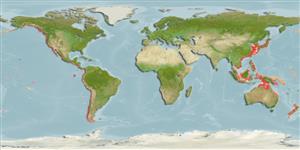Not assigned |
Sipuncula |
Golfingiidae
Environment: milieu / climate zone / depth range / distribution range
Ecology
Benthic; depth range 1 - 120 m (Ref. 1840). Subtropical
Pacific Ocean. Tropical to boreal.
Length at first maturity / Size / Weight / Age
Maturity: Lm ? range ? - ? cm Max length : 10.0 cm TRKL male/unsexed; (Ref. 1840); common length : 5.0 cm TRKL male/unsexed; (Ref. 1840)
Large animals, grayish-yellow, dark yellow, or gray in color. Trunk of adult specimens 2- 6 cm long, elongated and spindle-shaped. Introvert 1.5-2 times longer than trunk. Surface of trunk smoothseeming, as papillae covering it small. Papillae pyriform or finger-shaped. Tentacular apparatus obviously subdivided into dorsal crown surrounding nuchal organ and crown of perioral tentacles. Dorsal crown consisting of 19-30 tentacles. Tentacles of perioral crown
arranged into pronounced parallel festoons running along cephalon. In each festoon, pair of anterior tentacles closest to mouth opening with common basal fold encircling bases of tentacles. In large specimens, sometimes up to 20-30 festoons, each bearing two rows of
12-20 tentacles. Violet or yellow circles visible around apical ends of tentacles. Longitudinal
musculature of body wall solid, not divided into longitudinal bands. Two retractors of introvert, both ventral, fastened in posterior third of body, close to ventral nerve cord. Contractile vessel of complicated structure, covered with finger-shaped tubercles of orange or yellow color. Gut long, number of intestinal loops 18- 54. Two fixing muscles fastening upper regions of ascending and descending loops of intestine. Anal opening located level with nephridiopores. No rectal diverticulum found. Two nephridia, free, not fastened to body wall, length about 30 percent of body length.
Found on rocks, sand, silt and sea grass beds of the intertidal (Ref. 1783) and subtidal, shelf waters (Ref. 1840); coastal to shelf (Ref. 19). Subtidal, shelf waters (Ref. 1840); coastal to shelf (Ref. 19).
Life cycle and mating behavior
Maturity | Reproduction | Spawning | Eggs | Fecundity | Larvae
Maiorova, A.S. and A.V. Adrianov 2005 Ultrastructure of Microvillar Coelomocytes from the Trunk Coelom of Thysanocardia nigra Ikeda, 1904 (Sipuncula) from the Sea of Japan. Russian Journal of Marine Biology. 31(3):192-195. (Ref. 1783)
IUCN Red List Status
(Ref. 130435: Version 2025-1)
CITES status (Ref. 108899)
Not Evaluated
Not Evaluated
Threat to humans
Human uses
| FishSource |
Tools
More information
Trophic EcologyFood items (preys)
Diet composition
Food consumption
Predators
Population dynamicsGrowth
Max. ages / sizes
Length-weight rel.
Length-length rel.
Length-frequencies
Mass conversion
Abundance
Life cycleReproduction
Maturity
Fecundity
Spawning
Eggs
Egg development
Larvae
PhysiologyOxygen consumption
Human RelatedStamps, coins, misc.
Internet sources
Estimates based on models
Preferred temperature
(Ref.
115969): 7.1 - 20.6, mean 11.7 (based on 650 cells).
Fishing Vulnerability
Low vulnerability (10 of 100).
Price category
Unknown.
